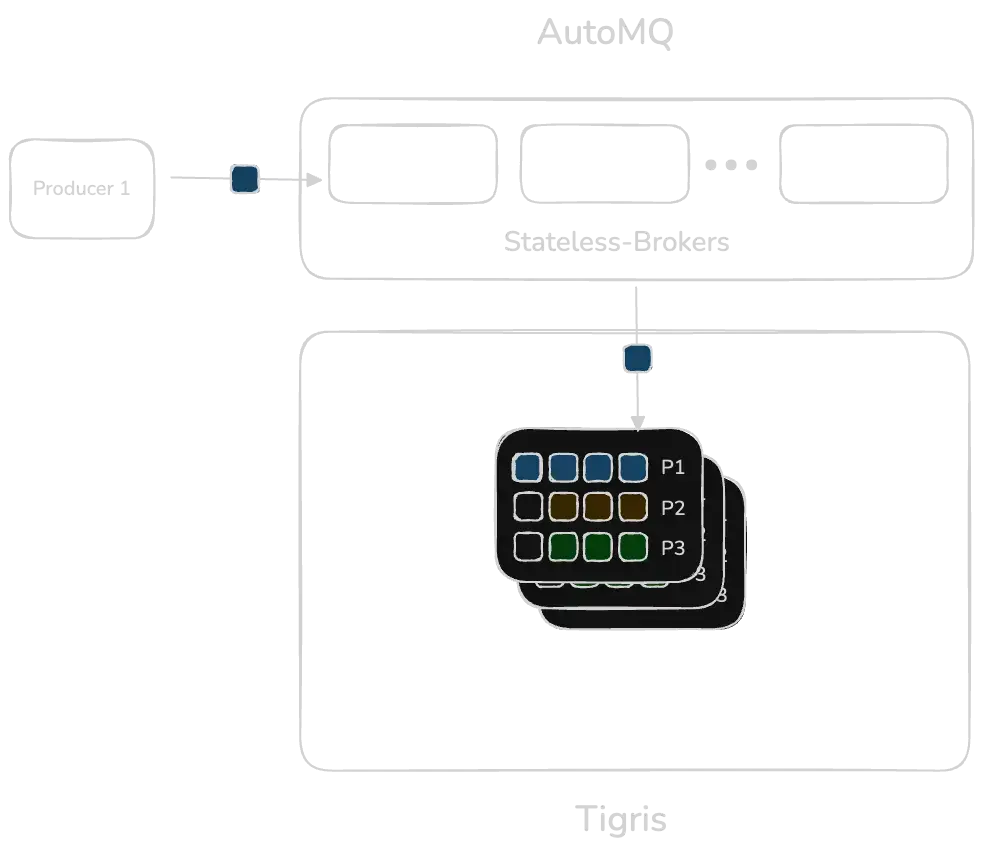Scaling Kafka with AutoMQ on Tigris

Apache Kafka® has been the standard for event streaming and building reliable, high-throughput, event-driven systems. However, as Kafka deployments scale across clouds and regions, its core architectural choices start showing limits.
In this post, we'll walk through Kafka's fundamentals, its scaling bottlenecks, and how AutoMQ with Tigris lets you scale storage and compute independently.
What is AutoMQ
AutoMQ is a fully Kafka-compatible streaming engine that re-implements the Kafka broker while preserving full protocol compatibility. Its defining architectural change is delegating persistence entirely to object storage like Tigris via the S3 API.
When you combine AutoMQ and Tigris:
- Brokers become fully stateless
- No local disks or attached volumes are required
- No intra-cluster replication is performed
- Storage is globally distributed with zero egress fees
- Compute and storage scale independently
Below is the architecture overview of AutoMQ and Tigris.
Where Kafka struggles at scale
AutoMQ paired with Tigris addresses several of Kafka's limitations at scale, including:
- Durability and partition replication overhead
- Slow, data-heavy partition reassignment
- Manual and operationally complex cluster balancing
To understand why these issues appear, we'll first explore Kafka's fundamental design.
Kafka in a nutshell
Fundamentally, Kafka is a distributed event streaming system made up of servers and clients.
Clients that write data are called Producers, and clients that read data are Consumers.
On the server side, Kafka is built around three core abstractions:
- Topics: named event streams (like tables in a database)
- Partitions: each topic is divided into one or multiple partitions
- Brokers: servers that store partitions locally on disk
Producers append messages to partitions while consumers read them sequentially. Kafka guarantees ordering within a partition and durable persistence on disk.

Durability & replication
Kafka ensures durability by maintaining at least 3 replicas per partition. Each partition has a leader and multiple followers forming an In-Sync Replicas (ISR) that must be nearly caught up with the leader's writes.

The replication flow is as follows: Producer writes to the leader. The leader writes to disk via page cache. Followers then fetch the new data from the leader that they persist and report back to the leader.
The downside with this approach is that every partition write becomes a fan-out stream to multiple brokers. At high throughput, the replication traffic dominates network usage, which forces operators to scale to larger EC2 instances and/or higher-bandwidth connections.
How AutoMQ and Tigris solve durability and replication
AutoMQ offloads the durability layer to Tigris as it inherently provides multiple replicas, offering extremely high data durability. Consequently, AutoMQ offers higher throughput by eliminating the need for data redundancy replication overhead.

A producer writes to any AutoMQ broker. The broker streams log segments directly into Tigris. Tigris stores each segment as an immutable object and replicates it across regions. Through this design:
- All brokers can access the same data without replication
- There is no follower lag or In-Sync Replica management
- Write throughput increases because internal fan-out disappears
Additionally, Tigris distributes the data globally, ensuring regional latencies for Producers and Consumers.

The diagram illustrates how AutoMQ operates when backed by Tigris object storage. A producer sends records to any AutoMQ broker, which remains stateless. Instead of writing log segments to local disk or replicating them across brokers, the broker streams each segment directly into Tigris. Tigris stores these segments as immutable objects per partition (P1, P2, P3) and replicates them across multiple regions. Because replication happens entirely within the storage layer, all brokers in any region see the same partition data without ISR management, follower lag, or inter-broker traffic.
Partition and cluster rebalancing
The challenges with rebalancing Kafka
Kafka stores data locally on each broker. When the cluster scales in or out, Kafka must:
- Copy partition data to new brokers
- Rebuild replicas
- Re-distribute leadership
This involves heavy disk I/O, large data movement, and long rebalancing workflows. Redistributing data can take hours or days, disrupting cluster performance.
AutoMQ eliminates this entire burden by shifting persistence to Tigris. By decoupling storage and compute, brokers scale independently, ensuring reads and writes operations are on and from Tigris, which acts as the source of truth.
Because the storage layer is shared, rebalancing becomes a lightweight metadata update rather than a multi-gigabyte data transfer. This enables instant partition reassignment, automatic traffic redistribution, and a continuously running self-balancing engine that keeps the cluster healthy without operator intervention.

Connecting AutoMQ to Tigris
Getting started is as easy as exporting a keypair into the environment:
KAFKA_S3_ACCESS_KEY=tid_YOUR_ACCESS_KEY_HERE
KAFKA_S3_SECRET_KEY=tsec_YOUR_SECRET_KEY_HERE
Follow our guide on how to connect Tigris to an AutoMQ instance running locally using Docker.
More importantly, AutoMQ's wire protocol mirrors Apache Kafka's, so existing clients, tooling and code remains unchanged. From an operator's standpoint, AutoMQ behaves like Kafka but removes the storage management dimension.
Conclusion
As Kafka scales, its dependence on local disks, ISR replication, and manual balancing becomes cumbersome. AutoMQ scales Kafka by decoupling storage and compute and moving durability, replication, and data distribution into Tigris' globally replicated object storage layer. Brokers become stateless, and scale instantaneously, while rebalancing becomes a metadata update.
Ready to scale your Kafka architecture?
If you're ready to run a globally distributed, fully elastic streaming engine, try AutoMQ on Tigris and experience the future of event streaming.